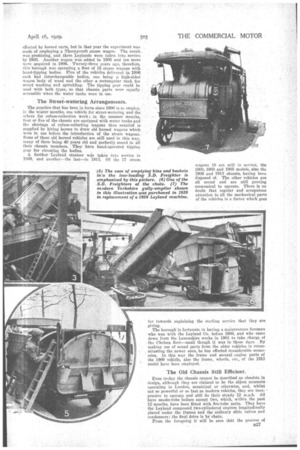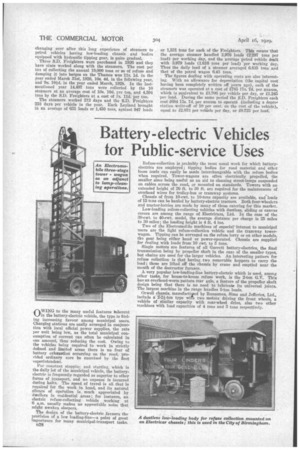26 YEARS' SERVICE
Page 96

Page 97

Page 98

If you've noticed an error in this article please click here to report it so we can fix it.
from STEAMERS
The Remarkable History of Chelsea's Refuse-Collecting Fleet ; Leyland Steamers Built in 1903 Still Performing Excellent Service for the Borough.
TEE municipal authorities in the Metropolitan Borough of Chelsea !were amongst the very earliest in the country to employ mechanical vehicles for the collection of refuse, and they have economically and satisfactorily maintained their fleet of steam wagons for over a quarter
of a century. Ever a progressive borough, Chelsea has nevertheless, a tradition for the preservation of old institutions, and the adoption by the council of mechanical means for scavenging and gully-emptying was not made without a prudent examination of the advantages of the modern system and a well-founded confidence in the need for dispensing with horsed transport.
The cleansing .problem of Chelsea has never been a simple one. The population at present is about 63,700, and there are 11,120 houses calling for attention. The area of the borough is 660 acres, or a little more than a square mile, and there are close on 33 miles of streets. The number of portable refuse bins is reckoned at between 12,000 and 34,000, and nearly a quarter of these must be emptied more than once weekly. There are also some 1,200 ashpits to be dealt with, nearly 100 of these being very large ones, and 400 or more of them requiring clearance twice a week or more often.
A regulation of the Chelsea Borough Council requires all refuse to he removed at least once every week, but in practice the proportion of buildings which has need for more frequent collection is very considerable. All the largest retail shops, the hospitals and Institutions are attended daily. There is no regulation to compel inhabitants to deposit their bins at the kerbside, so that the borough employees have to carry D26 the receptacles out from gardens, yards and areas.. Thousands of bins are brought through the houses to be emptied, and as 120 lb. is reckoned to be the average weight of a full bin the amount of labour iiivelved can be well appreciated, Until 1000 the work of refuse collection in Chelsea was
effected by horsed carts, but in that year the experiment was made of employing a .Thornycroft steam wagon. The result was prornising, and .three .Leylands were taken into service bY 1903. Another wagon was added in 1905 and ten more were acquired in 1900.. Twenty-three years ago, therefore, this borough was operating a fleet of 15 steam wagons with band-tipping bodies. Five .of the vehicles delivered in 1906
each had interchangeable bodies, one being a high-sided . wagon body of wood and the other a rectangular tank for street washing and sprinkling. The tipping gear could be ' used with both types, so that chassis parts were equally accessible when the water tanks were in use.
The Street-watering Arrangements.
The practice that has been in force since 1900 is to employ, in the winter months, one vehicle for street-watering and the others for refuse-collection work ; in the summer months, • four or five of the chassis are equipped with water tanks and tht:., shertage of refuse-collecting wagons thus entailed is supplied by hiring horses to draw old horsed wagons which were in use before the introduction of the steam wagona. Some of these old horsed vehicles are still used in this way, many of them, being 40 years old and perfectly sound in all their chassis members. They have hand-operated tipping gear for elevating the bodies.
A further Leyland steamer was taken into service in 1909, and enotber—the last—in 1915. Of the 17 steam wagons 10 are still in service, the 1900, 1903 and 1905 models, also the 1909 and 1913 chassis, having been disposed of. The other vehicles are all sound and are still proving economical to operate. There is no doubt that regular and scrupulous attention to all the mechanical parts of the vehicles is a factor which goes far towards explaining the sterling service that they are giving. The borough is fortunate in having a maintenance foreman who was with the Leyland Co. before 1900. and who ca.me down from the Lancashire works in 1901 to take charge of the Chelsea fleet—small though it was in those days. By making use of sound Darts from the older vehicles in reconstruetino• the newer ones, he has effected considerable economies. In this way the frame and several engine parts of the 1909 vehicle, also the frame, wheels, etc., of the 1913 model have been employed.
The Old Chassis Still Efficient.
Even to-day the chassis cannot be described as obsolete in design, although they are claimed te be the oldest steamers operating in London, municipal or otherwise, and, whilst not so powerful or so fast as modern vehicles, they are inexpensive to operate and still do their steady 12 m.p.h. All have smoke-tube boilers except two, which, within the past 12 months, have been fitted with lire-tube units. They have the Leyland compound.two-cylindered engines longitudinally placed under the frames and the ordinary slide valves and condensers; the final drive is by"chain.
From the foregoing it will be seen thfit the process of changing over after this long experience of steamers to petrol vehicles having low-loading chassis and bodies equipped with hydraulic tipping gear, is quite gradual. Three S.D. Freighters were purchased in 1926 and they have since worked along with the steamers. The cost per ton of collecting the annual 19,000 tons or so of refuse and dumping it into barges on the Thames was us. 1d. in the year ended March 31st, 1926, 10a. 4d. in the following year, and 9s. 10-1d. in the year ended March, 1928. In the lastmentioned year 14,497 tons were collected by the 10 steamers at an average cost of 10s. 1.0d. rer ton, and 4,594 tons by the S.D. Freighters at a cost of ,?s. lid, per ton.
The steamers worked 212 days and the S.D. Freighters 238 days per vehicle in the year. Each Leyland brought in an average of 631 loads or 1,450 tons, against 947 loads
or 1,531 tons for each of the Freighters. This means that the average steamer handled 2.976 loads (2.297 tons per load) per working day, and the average petrol vehicle dealt with 3.979 loads (1.616 tons per load) per working day. Thus the daily load of a steamer averaged 6.835 tons and that of the petrol wagon 6.43 tons.
The figures dealing with operating costs are also interesting. With no allowance for depreciation (the capital cost having been completely written off years ago), each of the steamers was operated at a cost of £785 17s. 7d. per annum, which is equivalent to f3.706 per vehicle per day, or £1.245 Pet load. During the same period the S.D. Freighters each cost £684 13s. 7d. per annum to operate (including a depreciation write-off of 10 per cent, on the cost of the vehicle), equal to £2.873 per vehicle per day, or £0.723 per load.








































































































































































































